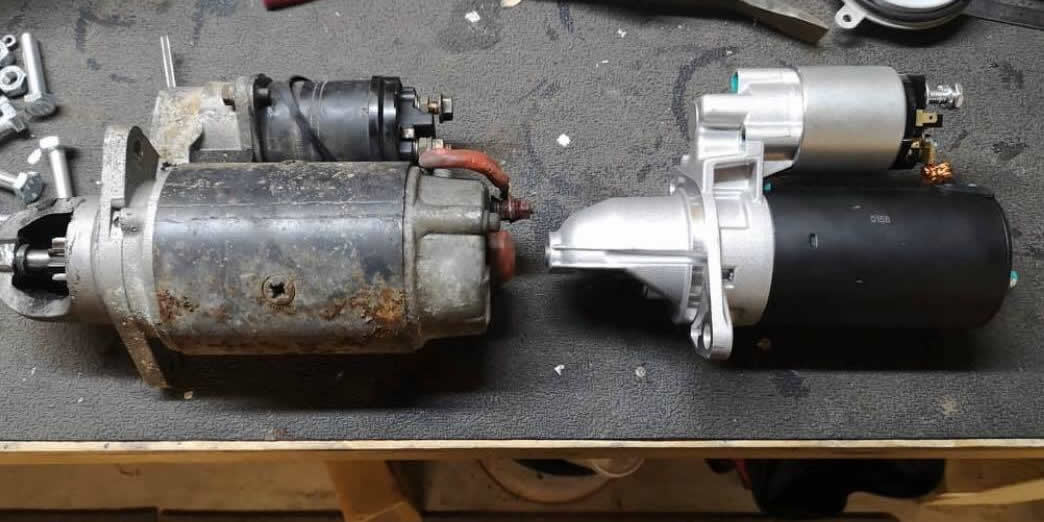Rather than calling out an auto mechanism, there are various ways to start a car with a bad starter. It’s a common problem with standard internal combustion engines and it can cause a major disruption or delays to your day.
In order for a starter motor to function correctly, it requires a positive current from the battery, ground connection and a positive current to the starter solenoid. Without these three aspects, the starter will not function correctly.
It’s important to note that the methods discussed below aren’t suitable for electric vehicles. If your EV has ran out of charge, the only option it to have it recovered and hooked up to an electric car charging station. Many EV’s can’t even be towed let alone “jump started” due to the complexity of the motor.
Table of Contents
8 Methods To Start a Car With a Bad Starter
- Jump start the car with a booster or cables.
- Push start the car if using a manual transmission.
- Check the wires between the battery and starter.
- Remove any corrosion and acid deposits.
- Tap the starter with a hammer.
- Bypass the starter relay.
- Check the engine grounds.
- Examine the starter solenoid wires.
* The above methods are discussed in further detail below.
1. Jump Start The Car
Depending upon whether you have the correct tools, jump starting the car is the best temporary fix to get your car started.
Although a fully functioning battery should be able to supply the battery with enough amperage, the extra boost can help overcome any potential dead spots in the starter.
The easiest method is to use a car jump starter, which you can use yourself but alternatively, if there is a nearby running car, you can use a set of jumper cables.
2. Push Start The Car
A more traditional method of starting a car with a bad starter is to perform a “push start”. However, it’s worth noting that this is only a suitable method for vehicles with a manual transmission because it requires the use of a clutch.
In order to push start the car, place the key into the “on” position, press the clutch down and then select the second gear. If the car isn’t on a decline, you will need someone to push the car from behind to speed of between 5 to 10 MPH.
Once you have reached that speed, simply release the clutch pedal for a second or less, which will send mechanical power to the alternator.
3. Check The Wired Connections
Depending upon the age of the car, the wires between the battery and alternator may have become loose. If this is the case, simply tighten the battery terminal connections and check the condition of the wires as the same time.
4. Remove Any Corrosion and Acid
Any corrosion or acid deposits that form upon the connections can cause a range of problems. The failure of the cable that sends power to the alternator may be the main cause of the issue and it can be easily cleaned up.
It’s advised to use a 50/50 mix of water and sodium bicarbonate to wash the terminal heads for the best result. Before attempting to clean the corrosion or acid with water, you should ensure everything is disconnected.
5. Tap The Starter With a Hammer
Depending upon how lucky you are feeling, you may be able to kick start the starter back to life by a small tap with a hammer. Whilst attempting to crank the engine, have someone tap the starter in various locations to bring it back to life.
It sometimes works as it can help the armature spin a small amount, which may start the engine. The reason why this works is because it disrupts the dead spots between the field coils and the armature.
6. Bypass The Starter Relay
Depending upon the age of the car, you may be able to bypass the starter relay.
This is made possible by touching both the positive starter terminal and solenoid terminal on the starter with a screwdriver. This sends a direct 12V current to the starter solenoid, which may power up the bad starter.
7. Check The Engine Grounds
A common reason for a bad starter is a faulty engine ground, which can be caused from a rusted or damaged. This has the effect of creating an open circuit within the starting system, which will prevent the starter from kickstarting into action.
It’s possible to bypass this issue by providing a direct ground from the battery but its certainly worth checking the engine ground wire for any obvious problems.
8. Examine The Starter Solenoid Wires
Closely related to the engine ground wire is the solenoid wires, which makes the starter engage with the transmissions ring gear. If there is an issue with the solenoid, the starter will turn freely whilst cranking.
For certain starter motors, you may be able to bypass the solenoid wiring by providing a direct 12V current to the solenoid. If you can hear a clicking noise whilst connecting the direct current, it’s possible to bypass it and start the engine.
Conclusion
When the starter motor is on its way out, it will usually provide you with certain symptoms such as long cranking of the engine. However, if it was to completely die out, the methods of starting a car with a bad starter above should help you out. Depending upon the age of the vehicle may determine whether you are able to carry out certain methods.

